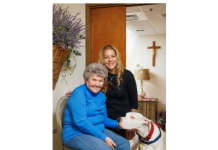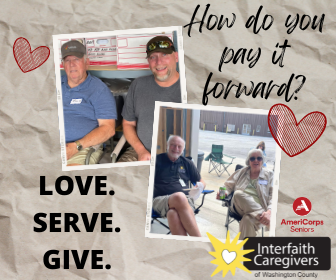November 11, 2019 – Washington Co., WI – The year was 1915, and the month was May. The First World War was raging, a battle that ultimately engaged 70 million men and women from across the globe, from 32 separate countries. Nine million of those soldiers never made it home. Their families were handed folded flags to hold instead of their loved ones. Additionally, seven million names from among civilians were added to death’s toll—an incomprehensible number, so many lives.
November 11, 2019 marks the 101st anniversary of the Great War coming to its end. Many countries will be using poppies, with their scarlet red petals, to remember the fallen from that battle.
How did the poppy become a worldwide symbol of military sacrifice? The answer to that question is a who: John McCrae.
McCrae was a soldier, an author, and a poet, and it was on a WWI battlefield in Belgium that he picked up his pen on May 3, 1915 and wrote “In Flanders Fields.” He was serving as a field surgeon, caring for the wounded, and his handwritten words were composed while he was sitting in the back of a military ambulance.
He had just buried one of his friends, a fellow soldier, and he was grieving. He stared out at the graves gathered round—they stretched on and on—and his eyes settled on beautiful wildflowers rising up from between them. Red poppies had pushed their blooms into the light of that broken world.
Poppies are one of the few flowers able to thrive in a place where fighting men and weaponry have left a landscaped scarred over. Poppies are hearty, quite stubborn; they wish to survive. McCrae looked at the poppies growing wild, sprung forth, planted there by nature’s mother, and the good doctor was moved by his emotions, inspired by the flowering ground.
Because of his poem, poppies were adopted by veterans everywhere quite quickly as a flower of remembrance after WWI’s conclusion. By the early 1920s, only a handful of years after WWI, the American Legion had joined efforts to use McCrae’s poetry in the hope of helping veterans. Poppies would have a purpose. McCrae’s words would be seeded into a larger vision, and that vision would grow.
But McCrae never lived to see that happen. His own grave was dug before the war was halted in 1918, and his lost life was among the many millions tallied.
I remember in my girlhood watching my father, who was a veteran, pin a poppy to the front of his shirt on Memorial Day and Veterans Day, or wind its wire through one of his buttonholes. These paper poppies had been made by veterans, handcrafted in VFW and Legion halls across America. Petals were pasted together, and flowers began to form. I liked to see those paper blooms when I was little, those poppies that had been made to financially help veterans—brother soldiers—who were disabled, wounded, or hospitalized.
The hometown of my childhood was a patriotic place. Curbside crowds rose to their feet on Main Street during Fourth of July parades when our community’s veterans came marching by. Respect pulled everyone up and out of their seated positions in lawn chairs.
Those same marching men could be found at card tables set up in front of our local grocery store on Veterans Day and Memorial Day. Red flowers would be in front of them—paper poppies—and a coffee can would be there on the table as well to collect donations. The poppies informed us. On sight, approachers knew that those men were veterans, knew that there was a meaning in those moments, that something important was happening in that simple scene.
Some people said thank you. Others saluted. Some shook the hands of those veterans. Many dug dollars out of their pockets, or coins, and placed them in the can.
As an elementary-school student long ago, I remember being asked to stand up from my desk at the eleventh hour on the eleventh day of the eleventh month and face east, toward Europe. Our whole classroom did this together and we stood silently, for two minutes. In that quietness, we remembered the sacrifices made by our soldiers. We learned way back then that 11:00 a.m. was the exact time the Armistice was signed on November 11, 1918.
As an adult, I continue to be inspired by poppies, and by the words that once flowed from a poet’s pen more than a century ago. All these years later, I dearly love visiting a garden and seeing poppies nodding their heads, poppies that were planted purposely for the remembrance of a soldier’s service. Setting aside a small area of earth in one’s own garden for memories is a way to surround ourselves with our beloveds—an uncle, a grandpa, a brother, a dad—who once served, and a way for a garden to hold our hearts. Living flowers can be planted with intention to keep those dear near—here.
I purchased a packet of poppy seeds from a veteran’s organization in 2018. The seeds were being distributed in this centennial year to commemorate the Great War’s conclusion. Several other organizations across America made poppy seeds available in 2018 also, including our country’s Junior Master Gardeners. Next spring, my packet’s seeds will be sprinkled into my garden and I will do my best to bring these poppies to life.
In the meantime, the ceramic poppies on my desk will keep me company this winter while my garden is waiting for me. These ceramic poppies were “planted” outside the Tower of London in 2014. The massive centennial effort to plant one artist-created poppy for each soldier who lost a life in the First World War serving Britain or its Colonies drew onlookers, too many to count, millions. People came. They stared. How many poppies had been planted? 888,246. Each had been hand-formed with six petals, then baked, then glazed. One poppy represented one life. One flower represented one name, and it was a very long list of names. Onlookers could see—visually see—the sacrifice that had been made. Tears fell as the poppies rose. Those who gathered knew that they were looking at more than flowers; they were looking at lives.
Each sturdy stem had been pushed into the ground by a “planter”—all planters were volunteers, nineteen thousand of them. The first poppies went into the ground in July of 2014 and the last was added on November 11, 2014 to acknowledge the war’s starting point in the summer of 2014, and to acknowledge the war’s end on November 11 four years later. Ever more poppies appeared over that stretch of time, more and more, all planted closely, and from a distance the flowers looked as if they were growing there naturally, in full bloom.
The queen herself came—Her Majesty—to walk through her country’s glass garden. Londoners followed her footsteps through that spread of red with their eyes. The color red was dominant against the Tower’s strong, 900-year-old stone walls which rose nearly a hundred feet high.
The poppy’s power had honored those lives lost so long ago—“Remember them!”—in a visible way.
Note: America’s first Armistice recognition was made on November 11, 1919 by President Woodrow Wilson. Congress later made Armistice Day a national holiday in 1938 to remember the fallen of WWI. “Armistice” Day was renamed “Veterans” Day in 1954. The focus was changed at that time to an honoring of all of America’s veterans, both living and nonliving. Memorial Day in May specifically honors our country’s deceased veterans.
Photo captions
WWI commemorative seed packet distributed in 2018
Commemorative poppy display at the Tower of London
July 2014 through November 2014
“In Flanders fields the poppies blow
Between the crosses, row on row.”
John McCrae










